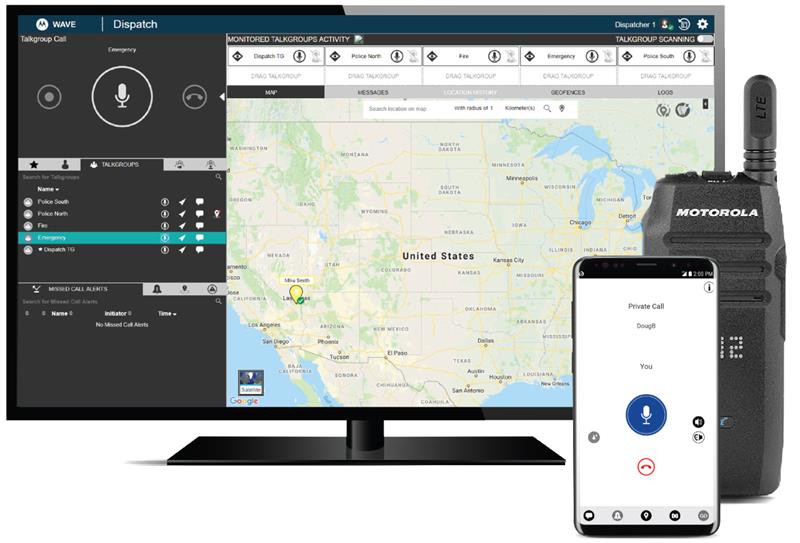Ensuring employees have the right connections to help them do their job has never been more complex. There are so many options – from radios and mobile phones through to mobile working applications. The right device or application can vary between job functions within a single workplace, so the ability to bring those together can be fundamental to maintaining business- or mission-critical communications.
Unified communications (UC) is the combination of different types of communication mediums into a single unified system. That might include radio, telephone, chat, video and other types of communications. This enables workers to communicate instantly and without boundaries.
Emerging capabilities are adding intelligence to that process, from usage analytics through to predictions, but what is essential is that employees are seamlessly connected through whatever device they need to use. Exactly how a UC solution is implemented will vary drastically across sectors, as the needs of a retail or office worker, for example, will be very different from those of someone working in public safety.
Depending on the requirements of an organisation, the solution will need to provide intensive and extensive links to cope with security, customer service and efficiency challenges. For business- and mission-critical users, it might also be vital to have instant communications via push-to-talk (PTT) over any device and network – allowing for shared talk groups and immediate one-to-many PTT over any connected device.
Ricardo Gonzalez, vice-president, strategy for EMEA at Motorola Solutions, explains: “Organisations needing business-critical communications are interested in productivity, infrastructure, and operational benefits. Whereas those that need mission-critical are looking more at safety and security.”
UC solutions can vary, but Graham Wilkinson, head of network services at Nimans, explains the fundamentals. He says: “UC is one of those phrases that has been bandied around for probably 20 years, but only in the last six to seven has it really started to mean anything. The development of hosted platforms has meant you can create one true UC and build a user experience around that. I guess that’s the key word – experience. True UC is not about one product, it’s about a collection of products brought into one seamless experience for the end-user.”
Wilkinson adds that early stage UC focused on bringing together voice and data. After that, he says, “the industry moved towards convergence, and from there UC was the next phase of that journey. Initially this was just an IP system, but then UC came along and it integrated and made things more seamless. You could have a lot more presence and capabilities rather than just voice through an IP network.”

Motorola Solutions sees UC as a way to expand communications beyond the boundaries of radio-based deployments. Gonzalez says: “Those two areas broadly cover the traditional market of LMR. We see UC as an extension of that same category. People look at UC as [an] extension of their radio network. They already have a familiarity with radio but need data capability or more coverage outside of their radio network.”
Gonzalez adds that UC can be used to share vital information with employees outside of more traditional radio user groups. “As an example, we helped a government customer recently that wanted a TETRA network for its main users but used our UC solution to extend the service to people that do not carry a radio, yet who, in special cases, need to be part of the band of communication.”
For organisations considering a UC solution, there is agreement between companies that these are relatively simple from a deployment point of view, if the right foundations are already in place. Nimans’ Wilkinson explains: “It’s more about getting the technology right before you launch. The interoperability of several providers coming together to give one solution – that’s the bit that can be difficult. The actual experience at the end is relatively simple. It’s about testing and making sure it does work together.”
Driving forces
In the past couple of years, organisations in the UK have been shifting towards Voice over Internet Protocol (VoIP) services for their phone systems. Borie Jalloh, product manager for fixed outbound voice at Vodafone UK, says: “British businesses are about to experience a major shift with the switch-off of the Integrated Services Digital Network (ISDN) traditional telephone lines, which commences this year. We will see legacy telephony systems incrementally shut down, creating a stepchange in the way companies communicate every day. Those still running on ISDN lines need to start looking at IP-based alternatives sooner rather than later, or else they’ll feel the rug being swept from beneath them when the service terminates in 2025.”
This chimes with the view of Steve McIntyre, chief marketing officer at Nimans: “VoIP really took off when BT made very firm its intentions to shut down the old [analogue phone] lines, and we’re seeing activity around that ramping up now. The bigger organisations have already got on board and made those changes, but it’s moving down the size of organisation. I’m still sure that by 2025 there’ll be some medium-sized organisations running around in a panic, not having realised the switch-off was on its way.”
Jalloh adds that the benefits of hosted telephony – using the cloud rather than private branch exchange (PBX) – are manifold. He says: “Rather than using costly and over-provisioned ISDN lines to cater for potential call demand on the busiest day, hosted telephony offers solutions that are much easier to scale in response to peaks and troughs in call volumes, significantly reducing unnecessary costs while offering far greater flexibility and scalability.
“Hosted telephony also opens the door for businesses to begin future-proofing their wider IT stacks. Once organisations have made the switch to IP-based communications and witnessed the positive impact of less expensive, more agile telephony, they typically begin considering other, newer tools to improve daily operations. Mobile work phones, videoconferencing and instant messaging collaboration platforms can all help support new ways of working, further unifying organisations’ communications packages.”
It is not just voice-based communications that are now being brought into the UC mix. Motorola’s Gonzalez says: “Once the customer has voice communication capabilities, the question becomes what else can I do? How can I use the data pipe to improve productivity, security, or simply to give more information to those out in the field? We move from the concept of PTT to PTX. It’s not just about voice, it’s about data, it’s about video. Being able to transmit live video back to the control room or share with other people in other locations means everyone can see what is happening to better coordinate the response.”
Live video could be particularly useful for firefighters, law enforcement, or those responding to accidents. Those not yet at the scene can start preparing for the situation they will arrive at.
New commercial models
These evolving technologies are leading to change across all aspects of UC, from how the solution is deployed through to the services’ commercial models. Alex Connors, head of portfolio strategy, unified communications and connectivity at Vodafone Business, says: “We’ve seen a real evolution in the way the [UC] service is delivered, going from being on-premise to largely cloud-based. Then there’s also been a change in the commercial models that the service is delivered by. The upfront charges that you would have had in building a huge complex collaboration platform disappear and everything becomes usage-based.”

Those factors are making UC appealing to a broader group of organisations. Connors adds that many customers are finding UC has a lower barrier to entry, particularly financially, as organisations no longer need to build a large on-premise solution that’s got a high amount of capex in advance. What’s more, moving to a service-based solution means the technology does not depreciate over the life of the contract.
Of course, there are some new factors to consider. Connors explains: “The thing that customers could be wary of is things like ‘bill shock’ and controlling costs within the organisation. As a service provider, we can deliver ways of managing costs and making sure that any bill shock is minimised. We give customers awareness of how many people are using the UC services and what capabilities they’re using.”
There are softer reasons why organisations are taking UC seriously. Nimans’ Wilkinson points to younger generations entering the workforce with the expectation that workplace technologies will be as seamless as the devices and apps they use in their personal lives. He says: “Everywhere you look in the UC marketplace, it’s about collaboration, interoperability, content sharing, easy access, remote access and modern working. You’ve got the infl uence of the millennials coming in, who will take an organisation’s technology capability as one of the big considering factors when choosing a role.
The tables have completely turned in that candidates used to be lucky to get offered a role, but now businesses need to make themselves attractive both from a social responsibility point of view, but also from an onboarding technology capability.”
The future of unified comms
Cellular will take up an increasing proportion of the UC puzzle in the coming years as LTE coverage expands and we step into the 5G era. Ensuring cellular networks are designed and configured in the right way will be vital. Motorola Solutions’ Gonzalez says: “5G brings more data capacity, which is good for users that want video. The challenge comes from situations when you have a high density of users in one area. Through network slicing, 5G can create networks that behave differently according to user demands. From my point of view, LTE is great, it already allows a lot of functionalities, but 5G will bring lots of other advantages for UC.”
The UC solutions themselves are also set to evolve. Vodafone’s Connors expects to see AI-driven UC services becoming the norm. Bringing artificial intelligence into unified communications and collaborations, he says, can make the user experience far richer and far more valuable. He gives automatic transcription or real-time translation services as some examples of AI-enhanced UC services. To put that into context, he recalls situations when working in an international business where colleagues wanted to switch to their first language for a portion of a meeting, especially if the topic was complex. “Bringing simultaneous translation into the UC mix could make conversations between colleagues far more efficient.”
The face of UC looks set to continue shifting in the years ahead, with the solutions on offer being transformed by new capabilities. New players might also emerge with new ideas about what truly unified communications should look like – even technology giants like Google are reportedly experimenting with their own UC apps – so we might see additional communication mediums being brought into the mix. The UC solutions that will be embraced by organisations will be those that bring the right functionalities together and provide a seamless experience for users.



